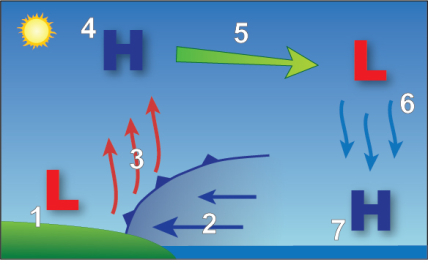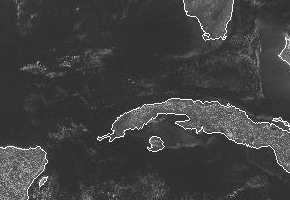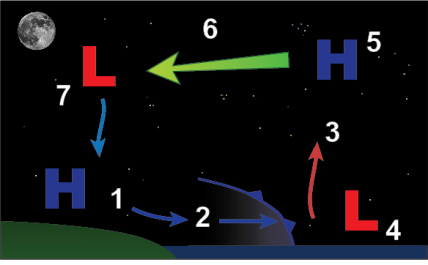The ocean's ability to absorb and store energy from the sun is huge. This is due to:
- The transparency of the water, which allows the sun's rays to penetrate deep into the ocean. In clear tropical water, light can reach a depth of 500-650 feet (150-200 meters), meaning that it takes a great amount of heat to raise the temperature through such a large volume of water, and
- The constant turbulence from wind and weather continually mixes the water, distributing surface heating through the water column.
In contrast to the ocean, the sun's rays do not to penetrate deep into the Earth but are confined to the top few inches of soil. Consequently, temperature fluctuations between daytime and nighttime are much greater over land than over water. For coastal areas, this difference, called differential heating, can have a large impact on the weather by the formation of the sea and land breezes.

The sea breeze circulation is composed of two opposing flows, one at the surface (called the sea breeze) and one aloft (which is a return flow). These two flows are a result of the difference in air density between the land and sea caused by the sun's heating.
The sun warms both the ground and ocean at the same rate. However, since the ground's heat remains confined to the top few inches of soil, it radiates back into the atmosphere, warming the air. As the air warms, its density decreases, creating a weak low-pressure area called a "thermal low" (1).
Over the adjacent water, the cooler, more dense air is pulled down by gravity and begins to spread inland (2).
This inland push of air from the ocean undercuts the less dense air over land, forcing it to rise (3). A sharp boundary develops due to the large difference between the air temperature over land and over water. This boundary, called a sea breeze front, acts in the same manner as the cold fronts often associated with a line of storms (when a cooler, denser air mass advances and replaces a warmer air mass, resulting in quick, significant temperature and weather changes).
For example, the air temperature drops significantly after the sea breeze front passes a location, sometimes as much as 15-20°F (8-11°C). The skies also clear and humidity increases after the sea breeze front passes, and there can be a significant change in wind direction and/or speed.
Over land, air forced up by the sea breeze front will begin to cool. This cooling means the density increases again, forming a small area of high pressure (4). Typically, this occurs from 3,000 to 5,000 feet (1,000 to 1,500 meters) in elevation. At this level, the air pressure and density, being greater than the same elevation over the water, causes air to flow back over water (5).
Once over water again, the air cools, increases in density, and sinks toward the Earth's surface (6). This enhances high pressure near the ocean's surface (7), and the whole process repeats as land-flowing air pushes the sea breeze front further inland. While the sea breeze is generally associated with the ocean, it can occur along the shore of any large body of water such as the Great Lakes.

These changes occur in a relatively small scale weather-wise. However, if there are larger scale atmospheric conditions also affecting the weather, then the sea breeze and sea breeze front can have a much larger impact on the type and intensity of weather one observes. Just like along cold fronts, if weather conditions are right, thunderstorms often develop along sea breeze fronts.
The location and number of thunderstorms will vary depending on the overall weather pattern over the region. For example, in Florida the amount of sunshine and prevailing surface wind over the state has a large impact on sea breeze thunderstorms. If the wind is relatively calm then the sea breeze can move well inland but with only scattered thunderstorms occurring about 1/3rd of the way across the peninsula.
Light west wind (5-10 mph) keeps the sea breeze front confined to the eastern coast but also makes for more widespread thunderstorms along the boundary. Stronger west winds can prevent the sea breeze front from moving onshore or forming at all, so no thunderstorms will occur. With prevailing east winds, they actually help push the sea breeze front and thunderstorms as much as half way across the peninsula.
On smaller peninsulas, such as at the northern tip of New Zealand, sea breezes from opposite coasts may collide. In these situations, two lines of thunderstorms may collide and combine into a single but intense, short-lived line.
The opposite of a sea breeze is a land breeze. While sea breezes occur during the day, land breezes occur at night. Despite the difference in times at which the land breezes and sea breezes occur, the reason for the land breeze's formation is basically the same as the sea breeze, but the role of the ocean and land is reversed.

Land breezes can occur when the land's nighttime temperature is less than the sea surface temperature. They are most common during the fall and winter seasons when water temperatures are still fairly warm and nights are cool. However, unlike the sea breeze, the land breeze is often much weaker.
At night, the land temperature falls to below that of the ocean, resulting in an increase in the air's density. Gravity's downward pull moves air downhill, spilling it onto the water (1). This denser air undercuts the lighter, warmer air over the water (2) forcing it up into the atmosphere (3). This rising air forms a weak low-pressure area (4).
The rising air accumulates aloft, forming an area of higher pressure (5) relative to the land at the same elevation. Air flows back toward land from high pressure to low pressure (6). Once back over land, the air cools, increases in density, and sinks causing an increase high pressure (7). Gravity pulls the dense air offshore again, completing the circulation.
Land breezes are weaker than sea breezes but not because of the difference in heating. Daytime heating and nighttime cooling occur at about the same rate so the potential for both land and sea breezes to be the same strength exists. But at night,
- The cooling ground inhibits vertical motion which, in turn, weakens the land breeze circulation,
- Nighttime cooling also produces a shallower change in temperature, so land breeze circulation is shallower, and
- Terrain, vegetation, and buildings inhibit the flow of air from land to water.

